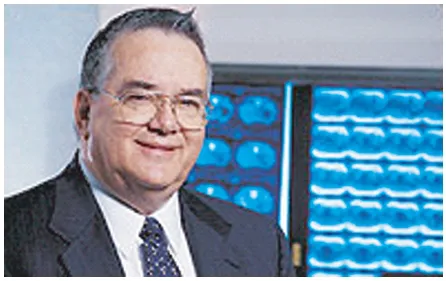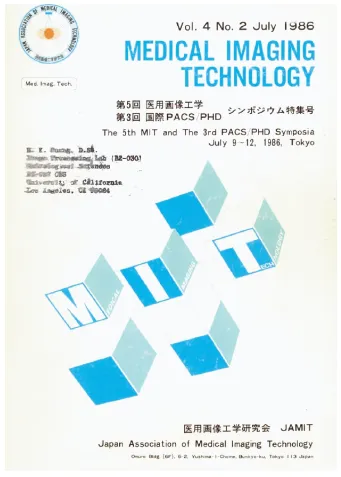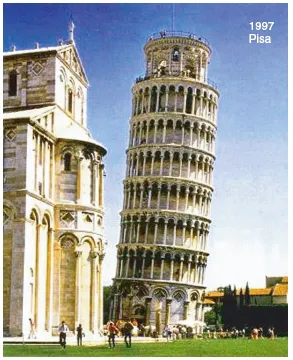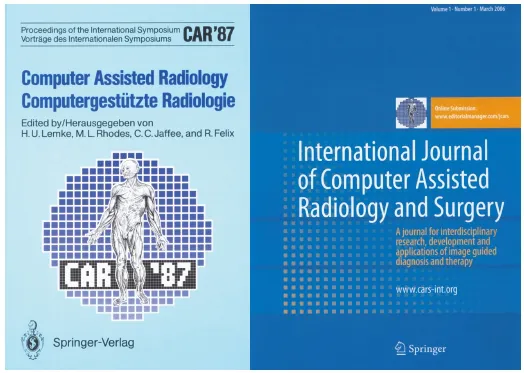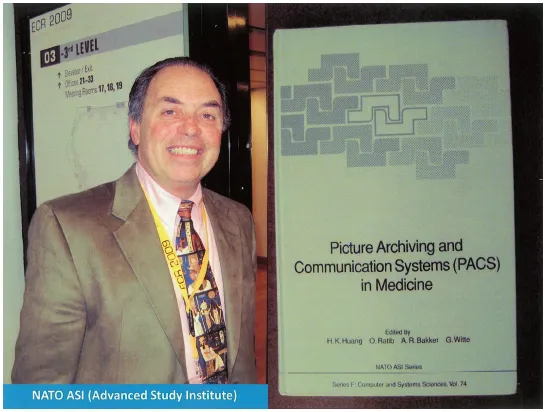![]()
CHAPTER 1
Introduction
1.1 INTRODUCTION
PACS (picture archiving and communication system) based on digital, communication, display, and information technologies has revolutionized the practice of radiology, and in a sense, of medicine during the past fifteen years. This textbook introduces the PACS basic concept, terminology, technological development, and implementation, as well as PACS-based applications to clinical practice and PACS-based imaging informatics. There are many advantages of introducing digital, communications, display, and information technologies (IT) to the conventional paper and film-based operation in radiology and medicine. For example, through digital imaging plate and detector technology, and various energy source digital imaging modalities, it is possible to improve the modality diagnostic value while at the same time reducing the radiation exposure to the patient; then through the computer and display, the digital image can be manipulated for value-added diagnosis. Also digital, communication, IT technologies can been used to understand the healthcare delivery workflow, resulting in a speed-up of healthcare delivery and reduction of medical operation costs.
With all these benefits, digital communication and IT are gradually changing the way medical images and related information in the healthcare industry are acquired, stored, viewed, and communicated. One natural development along this line is the emergence of digital radiology departments and digital healthcare delivery environment. A digital radiology department has two components: a radiology information management system (RIS) and a digital imaging system. RIS is a subset of the hospital information system (HIS) or clinical management system (CMS). When these systems are combined with the electronic patient (or medical) record (ePR or eMR) system, which manages selected data of the patient, we are envisioning the arrival of the total filmless and paperless healthcare delivery system. The digital imaging system, PACS, involves an image management and communication system (IMAC) for image acquisition, archiving, communication, retrieval, processing, distribution, and display. A digital healthcare environment consists of the integration of HIS/CMS, ePR, PACS and other digital clinical systems. The combination of HIS and PACS is sometime referred to as hospital-integrated PACS (HI-PACS). A PACS database contains voluminous health-related data. If organized and used properly, it can improve patient care and outcome. The art and science of utilizing these data is loosely termed as imaging informatics. The cost of healthcare delivery related to PACS, health-related IT, as well as imaging informatics has passed one billion dollars each year (excluding imaging modalities) and is still growing.
Up-to-date information on these topics can be found in multidisciplinary literature, reports from research laboratories of university hospitals and medical imaging manufacturers but not in a coordinated way. Therefore it is difficult for a radiologist, physician, hospital administrator, medical imaging researcher, radiological technologist, trainee in diagnostic radiology, and the student in physics, engineering, and computer science to collect and assimilate this information. The purpose of this book is to consolidate and to organize PACS and its integration with HIS and ePR, as well as imaging informatics-related topics, into one self-contained text. Here the emphasis is on the basic principles and augmented by discussion of current technological developments and examples.
1.2 SOME HISTORICAL REMARKS ON PICTURE ARCHIVING AND COMMUNICATION SYSTEMS (PACS)
1.2.1 Concepts, Conferences, and Early Research Projects
1.2.1.1 Concepts and Conferences
The concept of digital image communication and digital radiology was introduced in the late 1970s and early 1980s. Professor Heinz U. Lemke introduced the concept of digital image communication and display in a paper in 1979 (Lemke, 1979). SPIE (International Society for Optical Engineering) sponsored a Conference on Digital Radiography held at the Stanford University Medical Center and chaired by Dr. William R. Brody (Brody, 1981). Dr. M. Paul Capp and colleagues introduced the idea of photoelectronic radiology department and depicted a system block diagram of the demonstration facility at the University of Arizona Health Sciences Center (Capp, 1981). Professor S. J. Dwyer, III (Fig. 1.1a) predicted the cost of managing digital diagnostic images in a radiology department (Dwyer, 1982). However, technology maturation was lacking, and it was not until the First International Conference and Workshop on Picture Archiving and Communication Systems (PACS) at Newport Beach, California, held in January 1982 and sponsored by SPIE (Duerinckx, 1982; Fig. 1.1b,c), that these concepts began to be recognized. During that meeting, the term PACS was coined. Thereafter, and to this day, the PACS and Medical Imaging Conferences have been combined into a joint SPIE meeting held each February in southern California.
In Asia and Europe a similar timeline has been noted. The First International Symposium on PACS and PHD (Personal Health Data) sponsored by the Japan Association of Medical Imaging Technology (JAMIT) was held in July 1982 (JAMIT, 1983; Fig. 1.1d). This conference, combined with the Medical Imaging Technology meeting, also became an annual event. In Europe, the EuroPACS (Picture Archiving and Communication Systems in Europe) has held annual meetings since 1983 (Niinimaki, 2003), and this group remains the driving force for European PACS information exchange (Fig. 1.1e, f).
Notable among the many PACS-related meetings that occur regularly are two others: the CAR (Computer-Assisted Radiology; Lemke, 2002) and IMAC (Image Management and Communication; Mun, 1989). CAR is an annual event organized by Professor Lemke of Technical University of Berlin since 1985 (CAR expanded its name to CARS in 1999, adding Computer-Assisted Surgery to the Congress, and Professor Lemke is now with the University of Southern California). The Annual Proceeding of CARS became the International Journal of CARS in 2005 (Fig. 1.1g). IMAC was started in 1989 as a biannual conference and organized by Professor Seong K. Mun of Georgetown University (Mun, 1989), and its meetings were stopped in late 1990s. SPIE, EuroPACS, and CARS annual conferences have been consistent in publishing conference proceedings and journals that provide fast information exchange for researchers working in this field, and many have been benefited from such information sources.
A meeting dedicated to PACS sponsored by NATO ASI (Advanced Study Institute) was a PACS in Medicine Symposium held in Evian, France, from October 12 to 24, 1990. Approximately 100 scientists from over 17 countries participated, and the ASI Proceedings summarized international efforts in PACS research and development at that time (Huang, 1991b; Fig. 1.1h). This meeting was central to the formation of a critical PACS project: the Medical Diagnostic Imaging Support System (MDIS) project sponsored by the U.S. Army Medical Research and Materiel Command, which has been responsible for large-scale military PACS installations in the United States (Mogel, 2003).
The InfoRAD Section at the RSNA (Radiological Society of North America) Scientific Assembly has been instrumental to the continued development of PACS technology and its growing clinical acceptance. Founded in 1993 by Dr. Laurens V. Ackerman (and subsequently managed by Dr. C. Carl Jaffe, and others), InfoRAD has showcased live demonstrations of DICOM and IHE (Integrating the Healthcare Enterprise) compliance by manufacturers. InfoRAD has repeatedly set the tone for industrial PACS renovation and development. Many refresher courses in PACS during RSNA have been organized by Dr. C. Douglas Maynard, Dr. Edward V. Staab, and subsequently by the RSNA Informatics committee, to provide continuing education in PACS and informatics to the radiology community. When Dr. Roger A. Bauman became editor in chief of the then new Journal of Digital Imaging in 1998, the consolidation of PACS research and development peer-reviewed papers in one representative journal became possible. Editor-in-chief Bauman was succeeded by Dr. Steve Horii, followed by Dr. Janice C. Honeyman-Buck. The Journal of Computerized Medical Imaging and Graphics (JCMIG) published two special Issues on PACS in 1991 (Huang, 1991a); PACS—Twenty Years Later summarized in 2003 (Huang, 2003a) the progress of PACS before 2003 in two 10-year intervals (Fig. 1.1i).
1.2.1.2 Early Funded Research Projects by the U.S. Federal Government
One of the earliest research projects related to PACS in the United States was a teleradiology project sponsored by the U.S. Army in 1983. A follow-up project was the Installation Site for Digital Imaging Network and Picture Archiving and Communication System (DIN/PACS) funded by the U.S. Army and administered by the MITRE Corporation in 1986 (MITRE, 1986). Two university sites were selected for the implementation, University of Washington in Seattle and Georgetown University/George Washington University Consortium in Washington, DC, with the participation of Philips Medical Systems and AT &T. The U.S. National Cancer Institute, National Institutes of Health (NCI, NIH) funded the University of California, Los Angeles (UCLA) several large-scale PACS-related research program projects under the titles of Multiple Viewing Stations for Diagnostic Radiology, Image Compression, and PACS in Radiology started in mid-1980s and early 1990s.
1.2.2 PACS Evolution
1.2.2.1 In the Beginning
A PACS integrates many components related to medical imaging for clinical practice. Depending on the application, a PACS can be simple, consisting of a few components, or it can be a complex hospital-integrated or an enterprise system. For example, a PACS for an intensive care unit in the early days may comprise no more than a scanner adjacent to the film developer for digitization of radiographs, a base band communication system to transmit, and a video monitor in the ICU (Intensive care unit) to receive and display images. Such a simple system was actually implemented by Dr. Richard J. Steckel (Steckle, 1972) as early as 1972. Nowadays some hospitals install a CT (computed tomography) or MRI (magnetic resonance imaging) scanner connected with a storage device and several viewing stations would also call these components as a PACS. On the other hand, implementing a comprehensive hospital-integrated or enterprise PACS is a major undertaking that requires careful planning and multimillion US dollars of investment.
PACS operating conditions and environments have differed in North America, Europe, and Asia, and consequently has PACS evolution in these regions. Initially PACS research and development in North America was largely supported by government agencies and manufacturers. In the European countries, development was supported through a multinational consortium, a country, or a regional resource. European research teams tended to work with a single major manufacturer, and since most early PACS components were developed in the United States and Japan, they were not as readily available to the Europeans. European research teams emphasized PACS modeling and simulation, as well as the investigation of image processing components of PACS. In Asia, Japan led the PACS research and development and treated it as a national project. The national resources were distributed to various manufacturers and university hospitals. A single manufacturer or a joint venture from several companies integrated a PACS system and installed it in a hospital for clinical evaluation. The manufacturer’s PACS specifications tended to be rigid and left little room for the hospital research teams to modify the technical specifications.
During the October 1997 IMAC meeting in Seoul, South Korea, three invited lectures described the evolution of PACS in Europe, America, and Japan, respectively. It was apparently from these presentations that these regional PACS research and development enterprises gradually merged and led to many successful international PACS implementation. Five major factors contributed to these successes: (1...

